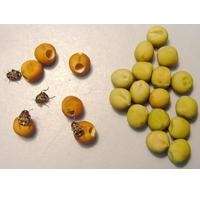Destructive pea weevils on the way out

(Phys.org)—Farmers around the world are a step closer to eliminating the chemical spraying of field peas for the destructive pea weevil, thanks to research by agricultural scientists from The University of Western Australia.
The weevils, which affect crops grown in warmer climates, are the most damaging insect threat to the peas. They burrow into pods that are still growing and hollow out peas by the time they are harvested or during storage. Weevil damage is impossible to detect until the next generation of beetles emerges post-harvest, by which time crop yields and quality have been significantly affected.
So far the only way to control pea weevils is to spray crops with insecticides or fumigate the harvested seeds - an expensive, environmentally unfriendly and only partially effective practice.
Crop scientists have spent years trying to isolate pea weevil-resistant genes to create stronger field pea varieties that don't need pesticide protection. Previously they have had to rely on a time-consuming and impractical screening process which slowed attempts to breed better field peas.
In a research leap that will benefit field pea growers across the globe, a team including Associate Professor Guijun Yan, of UWA's School of Plant Biology and Institute of Agriculture, has now developed a quick, reliable and cheaper method to screen field pea varieties on a large scale.
The breakthrough has enabled UWA researchers to identify pea weevil-resistant genes within wild field pea varieties and begin introducing the genes to cultivated field peas via traditional breeding methods.
Field peas are one of the world's oldest domesticated crops dating back to the Stone Age and are a major food source for humans and animals globally. Australia alone produces 400,000 tonnes of field peas annually for export and local consumption.
Associate Professor Yan said more work needed to be done but the discovery meant farmers could have access to pea weevil-resistant pea varieties within 5-7 years.
"We have moved forward," he said. "We have developed a technique to screen, identified the gene and been able to bring it back to the cultivated pea. The work now needs to continue but it's a very good discovery.
"It will lead to the elimination of pee weevil insecticides, enable farmers to increased their pea yields and provide consumers with better quality peas."
The previous method of screening for resistant lines of field pea (glasshouse bioassay) meant only about 30 plants - with 20 seeds per plant - could be screened in a day. The new method, which involves separating pea weevil-infested and non-infested seeds by density in a solution of Caesium chloride, means up to 400 plants - regardless of the number of seeds - can be screened in a day.
The four-year study was funded by the Australian Research Council and published this month in the journal Crop and Pasture Science.
Provided by University of Western Australia



















